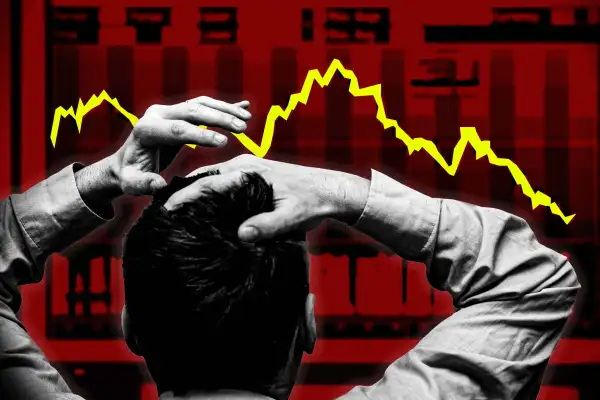Could Automatic Trading Halts Stop a Stock Market Crash?
Money is not a client of any investment adviser featured on this page. The information provided on this page is for educational purposes only and is not intended as investment advice. Money does not offer advisory services.

On Monday morning, the S&P 500 briefly entered a bear market, joining the Nasdaq Composite with losses exceeding 20% from recent highs. At the time of writing, the index has recovered some of those losses but remains down 18.15% from its all-time high on Feb. 19, raising concerns about the possibility of trading halts after last week's massive single-day losses.
Between the fallout from President Donald Trump's tariff announcement and a general ongoing drop in investor sentiment, broad panic-selling has ensued and speculation about the use of so-called circuit breakers has resurfaced. But what are the market's circuit breakers, and how far do stocks have to fall before they are applied?
What are circuit breakers?
Circuit breakers were implemented in the aftermath of the Black Monday stock market crash of 1987 as a means of stabilizing prices amid periods of elevated volatility and dramatic price swings. According to the U.S. Securities and Exchange Commission, these procedures allow for coordinated cross-market trading halts if a severe market price decline reaches levels that may exhaust market liquidity.
In other words, circuit breakers are used in situations when the number of buyers or sellers have been depleted as a tool to prevent further price collapses.
Also referred to as trading halts, there are three thresholds for circuit breakers to trigger:
- Level 1: Intraday trading results in a decline of 7% from the prior trading session's close
- Level 2: Intraday trading results in a decline of 13% from the prior trading session's close
- Level 3: Intraday trading results in a decline of 20% from the prior trading sessions' close
Additionally, if a decline of 7% or 13% occurs before 3:25 p.m. EST, a 15-minute market-wide halt will be enacted. However, if those losses occur at or after 3:25 p.m. EST, no halt will be enacted. Any market decline that triggers a Level 3 circuit breaker — at any point in the day — will halt market-wide trading for the remainder of that trading day.
Why conditions are ripe for trading halts
Stock market volatility, as gauged by the Chicago Board Options Exchange's CBOE Volatility Index (VIX), is currently at its highest level since Trump's last presidency. Looking further back, the only time it has been higher in the past 20 years was during the Great Financial Crisis in 2008. So when stock futures on Sunday indicated ongoing heightened volatility and looming declines at market open on Monday, rumors of trading halts were pervasive.
Based on those futures, the implication was that the major indexes would experience ongoing selling carried over from last week's record market losses, which saw $6.6 trillion of value wiped out from the market. That was the largest two-day loss of shareholder value on record, according to Dow Jones data. From Thursday's close to Friday at 3:00 p.m. EST, the S&P 500 lost 5.56%, bringing it within 1.44% of a Level 1 trading halt before the 3:25 p.m. EST requirement.
Trading halts aren't limited to broad indexes. They can also be triggered for individual equities, which have looser rules. For example, by 11 a.m. EST on Monday, 163 stocks and exchange-traded funds (ETFs) were halted between the Nasdaq, New York Stock Exchange and BATS Global Markets.
Why circuit breakers are hotly debated
Circuit breakers were designed to stave off rapid price changes. However, since 1987, their use has been a point of debate. In the 1987 instance, the need for stabilization came amid a massive sell-off. But more recently, trading halts have been enacted due to rapid price escalations.
During the now-famous GameStop (GME) short squeeze, retail investors looking to take advantage of short sellers targeting GME banded together, resulting in a surge of buying volume that doubled prices in just 90 minutes of trading on Feb. 24, 20201. Trading of the stock was halted by Robinhood and other brokerages twice after shares of GME surged 104%.
The event gave rise to the discussion about whether brokerages should have the right to restrict investor trading and if circuit breakers could be justified outside of the need for price stability. In the GameStop instance, retail investors alleged a conspiracy implicating Robinhood of halting trading in order to aid now-defunct hedge fund Melvin Capital, which was suffering massive losses that ultimately led to its failure.
According to the Fordham Journal of Corporate & Financial Law, "the decision to halt trading presented Robinhood as siding with the rich and taking from the poor, contracting Robinhood's namesake and stated mission of making investing accessible to the masses," and questions have emerged about who should shoulder the risk of meeting collateral requirements.
Circuit breakers are also seen as controversial advantages for institutional investors that enable them to better time trades after the halts expire. Critics also argue that trading halts can hinder market efficiency and lead to increased volatility after the halt is lifted.
More from Money:
Can Skipping Avocado Toast and Lattes Really Help You Buy a House?
'Anything Works in a Bull Market.' But What About a Bear Market?
Cash Isn't King: Why Investors Shouldn't Sideline Their Money Right Now



